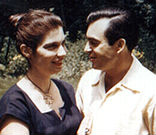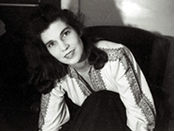 About the Radakoviches
About the Radakoviches
Ruth Clark Radakovich and Svetozar (Toza) Radakovich are best known for the innovative sculpture and jewelry they created over the span of four decades, from the 1950s through the 1980s. While both artists were classically trained in painting, it wasn't until they were together that they began to explore the techniques and media of the jewelry and sculpture for which they became known.
They worked in metal, wood, stained glass, enamel, plastic and fiberglass and crafted every thing from large abstract works to intricately carved doors. Ultimately, it was the extraordinary finesse that set apart their jewelry design. They mastered precision lost wax dental casting techniques which they applied to jewelry in creating their "wearable sculpture". The unique pieces they wrought decades ago still surprise and delight the contemporary eye.
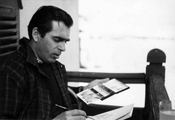 Toza studied at the Royal Academy of Art in Belgrade for six years and received his Masters of Fine Arts in painting and design in 1939. He was an outstanding athlete and was awarded as national swimming champion and national giant slalom ski champion during his school years. If Yugoslavia had had the funds to participate, he would have represented his country in the Olympics.
Toza studied at the Royal Academy of Art in Belgrade for six years and received his Masters of Fine Arts in painting and design in 1939. He was an outstanding athlete and was awarded as national swimming champion and national giant slalom ski champion during his school years. If Yugoslavia had had the funds to participate, he would have represented his country in the Olympics.
Ruth spread her formal training out as her school years coincided with WWII and she took time out to work in a bomber factory. She began at Sarah Lawrence in 1939 then on to include Mills College and the University of Michigan at Ann Arbor to earn her Bachelors of Fine Arts there in 1949. She majored in Anthropology before shifting to the arts.
While Toza spent the war fighting and going to prison, Ruth was in the United States learning to fly a plane in the hopes of getting into the Air Force. A back injury and a case of amoebic dysentery, contracted in Peru where she was studying anthropology, kept her out of the military. She was a liberal political activist, a humanitarian and enjoyed journalism.
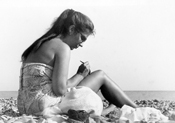 In the early 1950s she studied metalworking at the School for American Craftsmen both at Alfred University and Rochester Institute of Technology, and at the University of Rochester, NY.
In the early 1950s she studied metalworking at the School for American Craftsmen both at Alfred University and Rochester Institute of Technology, and at the University of Rochester, NY.
After the war, she volunteered to work with United Nations Relief and Rehabilitation Administration (UNRRA) and in 1946 was sent to Belgrade, Yugoslavia, one of most devastated countries in Europe. Toza worked in their public relations department as a graphic artist. When they met, they were unable to speak a common language, but in "me Tarzan you Jane" style they found ways to communicate and quickly fell in love.
In 1947 UNRRA had served its purpose and was dissolved. Ruth was forced to leave as Yugoslavia was not open to tourists. Toza was not permitted to leave the country. The sudden separation was devastating. As Shakespeare observed, "the course of true love never does run smooth" and it took Toza and Ruth seven years to finally be together. The first hurdle was to get Toza out of communist Yugoslavia.
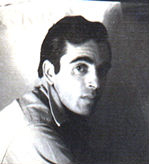 Toza was hired to work as a graphic artist for the prestigious national magazine, Jugoslavia, and Ruth returned to the states. For many this would have signaled the end, but they were determined, and kept their forbidden relationship very much alive. During the long separation, they employed their creative talents and developed clandestine ways to communicate. Through cracks in the iron curtain, messages went back and forth between them rolled up and hidden in pill bottles and scribed in impossibly tiny print then covered over with watercolor paintings. The authorities watched Toza closely.
Toza was hired to work as a graphic artist for the prestigious national magazine, Jugoslavia, and Ruth returned to the states. For many this would have signaled the end, but they were determined, and kept their forbidden relationship very much alive. During the long separation, they employed their creative talents and developed clandestine ways to communicate. Through cracks in the iron curtain, messages went back and forth between them rolled up and hidden in pill bottles and scribed in impossibly tiny print then covered over with watercolor paintings. The authorities watched Toza closely.
In 1951 Yugoslavia opened its border to tourists and Ruth was among the first allowed in. She managed to stay five months. Against Toza’s better judgement, she approached the Ministry of Interior for and exit visa for him. She was immediately deported and Toza was arrested for associating with a foreigner and sent to jail. After his release they continued to communicate in secret and to plan his escape.
Finally, they devised what seemed to be a feasible escape plan. Over time, disguised in the C.A.R.E. packages she continued to send his family. Ruth sent all the pieces of a small boat that Toza would practice assembling quickly in the dark and would use to make a midnight crossing to Italy where she would be waiting. He had twice escaped prison camps, he could escape the country.
But the darker forces of Yugoslavia were omnipresent. He had chosen a bad day to execute his plan. The Navy had scheduled the same day to practice maneuvers; his isolated beach was crawling with military. In desperation he stole a small navy boat and headed for Bari, a daunting distance. About halfway across the Adriatic the engine died and Toza worked frantically to fix it. Finally it sputtered to life but this escape was doomed. A navy plane spotted him and fired warning shots into the water all around him. As the Italian shoreline, and freedom came into view, a Yugoslav navy patrol boat pulled alongside and took Toza into custody. He was arrested and taken to prison, again. Ruth waited helplessly.
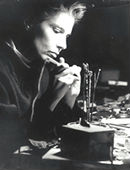 On the Italian coast, where Ruth was anxiously waiting, a gripping dread slowly grew in Ruth as she began to realize too much time had passed. Something had gone wrong. She dared to write to his mother. She had to find him.
On the Italian coast, where Ruth was anxiously waiting, a gripping dread slowly grew in Ruth as she began to realize too much time had passed. Something had gone wrong. She dared to write to his mother. She had to find him.
The escape had failed and the formidable task of finding Toza, what prison he was in and getting him released - if he was alive, fell to his mother.
After months of relentless searching, his mother, Milica - a woman not to be tangled with, located the prison where he was being held and negotiated his release. He went back to work for Jugoslavia magazine. Time passed and inexplicably Toza was granted a work visa to travel briefly to Paris as the magazine's art editor. Some official had failed to notice his file.
In mid 1952, Toza arrived in Paris, the city of artists, and was transformed from political prisoner to free citizen in one day. His sense of freedom left him breathless and he spent days mesmerized by the streets and the free life around him. He could do what he wanted - no more sneaking around, no more secret police. He wrote to Ruth and waited. She came as fast as she could; unbelievably their separation was over.
Freedom had its price however, and the bureaucrats of France required Toza to renew his visa every three days. After a year and a half of non stop frustration, they decided to go to Denmark, the only country that would accept a Yugoslav refugee.
In Copenhagen they studied jewelry casting with Mogens Bjorn Anderson. Toza's work was exhibited at the Copenhagen Handwork Museum and he was given a solo show at the Gallery Binger.
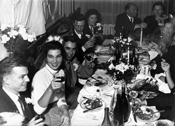 At last the news came that the French government had granted them an interview for permission to marry. They packed up and drove as fast as they could to Paris. Toza shaved in the subway barely making the interview that would determine their future. On Jan 9th 1954 they were married in Paris.
At last the news came that the French government had granted them an interview for permission to marry. They packed up and drove as fast as they could to Paris. Toza shaved in the subway barely making the interview that would determine their future. On Jan 9th 1954 they were married in Paris.
He painted with new inspirations in their small studio apartment and made a living as a house painter. He was mesmerized by the exploding art scene in Paris and studied the young painter Zao Wou Ki. Soon his paintings were being noticed. Gallery Marseilles gave him a one man show. His work was included in a "Discoveries" exhibition and he was featured in Réalités magazine as a "young discovery".
Then after waiting 2 years and $22,000. francs for official stamps on 32 documents, Toza was given his papers to marry his American girl. They began the six month wait for passage on the SS Liberté. During their last time in Europe, now allowed to travel, they visited museums and cave paintings at Lascaux and Altamira. They studied filigree in Italy acquiring yet another technique in fine jewelry making.
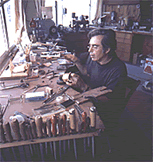 On February 21st, 1955 they arrived at Ellis Island, New York. They settled in Rochester where they continued to study metalwork at the School for American Craftsmen, where Ruth had been, and at Rochester Institute of Technology. They learned precision casting from their dentist turned jewelry professor. Within a month of being in the country Toza began to win awards for his paintings.
On February 21st, 1955 they arrived at Ellis Island, New York. They settled in Rochester where they continued to study metalwork at the School for American Craftsmen, where Ruth had been, and at Rochester Institute of Technology. They learned precision casting from their dentist turned jewelry professor. Within a month of being in the country Toza began to win awards for his paintings.
He received an appointment to teach painting, drawing and design at the School for American Craftsmen, RIT in 1955 and in early 1956 he began teaching metalwork at the University of Rochester's Memorial Art Gallery where Ruth had also been teaching.
In Rochester they found an ideal life. Their peers, most of whom became life long friends, were a group of like minded craftsmen. By late 1958 they had two children and following Toza's love for the sea, decided to move to Encinitas, California. They joined the Allied Craftsmen of San Diego and became very active in the art community and hosted legendary parties.
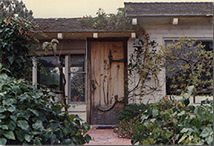 There they shared a life of love and family and a driving need to explore the natural world and mine its secrets. Next to their small wood and concrete brick house, they designed and built a studio where their art took form, often in the company of their two daughters Jeanie and Saika. The studio quickly filled with equipment for working in all the media they explored. Besides painting and metal work, they learned to work in wood, stained glass, plastics, stone and fiberglass. Toza began making larger outdoor sculptures. The family favorite was a colorful climbing structure, of galvanized irrigation pipes, they designed together in hopes of keeping their children off the furniture.
There they shared a life of love and family and a driving need to explore the natural world and mine its secrets. Next to their small wood and concrete brick house, they designed and built a studio where their art took form, often in the company of their two daughters Jeanie and Saika. The studio quickly filled with equipment for working in all the media they explored. Besides painting and metal work, they learned to work in wood, stained glass, plastics, stone and fiberglass. Toza began making larger outdoor sculptures. The family favorite was a colorful climbing structure, of galvanized irrigation pipes, they designed together in hopes of keeping their children off the furniture.
In 1961 Toza taught metalwork at the University of Arizona's Southwest Indian Project where he met Hopi jeweler Charles Loloma. A lifelong friendship began which brought him back to the Hopi reservation many times to exchange metalworking techniques and ideas. Toza also taught at San Diego State University and in 1966 established a course in bronze casting there after learning the process from James Hubbell. As Ruth and Toza's careers at home as designer-craftsmen became more demanding, Toza gave up teaching at SDSU. In the early 1970's he established and taught a jewelry casting class at Palomar College.
The Radakoviches were prolific artists and their creations reflect the beauty they found there. Everything served as inspiration: cities and buildings, the wires and towers of the industrial world as well as the natural landscapes, particularly the sea - Toza's lifelong love. Among the many artists they admired were sculptors Mirko Basaldella, Kenneth Armitage, David Smith and Henry Moore as well as fellow jewelers, John Paul Miller, Ronald Hayes Pearson, Jack Prip and Arline Fisch.
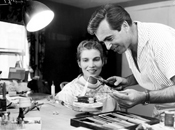 Although they worked in many genres, Ruth and Toza were best known for their exquisite jewelry. "Unlike sculpture that stands alone, explains Ruth, .. a piece of jewelry must serve human majesty. It must expand the wearer, and it must create an impact on all who see it." Toza, however, was not so concerned with the wearer but with the construction of the piece. "I have a very strong feeling that forms for jewelry not be flat. There's a whole dimension that adds tremendous richness to it, and when a person moves, you see a piece from different angles and it becomes a different piece each time you see it. That's what so nice about jewelry, it has so many possibilities."
Although they worked in many genres, Ruth and Toza were best known for their exquisite jewelry. "Unlike sculpture that stands alone, explains Ruth, .. a piece of jewelry must serve human majesty. It must expand the wearer, and it must create an impact on all who see it." Toza, however, was not so concerned with the wearer but with the construction of the piece. "I have a very strong feeling that forms for jewelry not be flat. There's a whole dimension that adds tremendous richness to it, and when a person moves, you see a piece from different angles and it becomes a different piece each time you see it. That's what so nice about jewelry, it has so many possibilities."
Toza liked to build surprises into his jewelry. He would occasionally fashion a bracelet or ring with a plain, even austere exterior that had its underside inlaid with an intricate mosaic that only the designer and the owner knew about. He felt this was a direct influence of nature, where beauty is often concealed. In making such pieces, Toza forged a bond with the wearer that would outlast style, fancy and fad.
The life these two had worked so hard to create ended too soon when Ruth died in 1975 at the age of 54. The creative force that grew from their partnership continued to inform Toza's work. In 1985 he was honored as a "Living Treasure of California". He passed away at age 80 in 1998. During their prolific time on earth, the Radakovich's work was exhibited and written about nationally and internationally.
Today their exquisite works endure with individual collectors, museum collections, exhibitions and in publications.
Their daughter Jean is currently in production on their documentary. Please visit the documentary page for more information.

